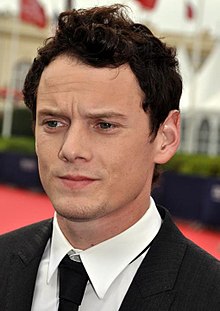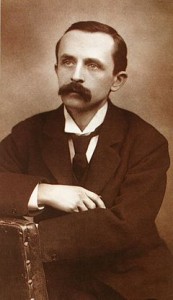 On this day in 1937, author and dramatist, J. M. Barrie died of pneumonia in London at the age of 77. Born James Matthew Barrie on 9 May 1860 in in Kirriemuir, Angus, Scotland. Perhaps best remembered as the author of Peter Pan, or The Boy Who Wouldn’t Grow Up (1904) the play about the ageless boy and an ordinary girl named Wendy who have adventures in the fantasy setting of Neverland. The play was developed by Barrie into the 1911 novel Peter and Wendy. George Bernard Shaw described the play as “ostensibly a holiday entertainment for children but really a play for grown-up people.”
On this day in 1937, author and dramatist, J. M. Barrie died of pneumonia in London at the age of 77. Born James Matthew Barrie on 9 May 1860 in in Kirriemuir, Angus, Scotland. Perhaps best remembered as the author of Peter Pan, or The Boy Who Wouldn’t Grow Up (1904) the play about the ageless boy and an ordinary girl named Wendy who have adventures in the fantasy setting of Neverland. The play was developed by Barrie into the 1911 novel Peter and Wendy. George Bernard Shaw described the play as “ostensibly a holiday entertainment for children but really a play for grown-up people.”
When he was 6 years old, Barrie’s next-older brother David (his mother’s favourite) died two days before his 14th birthday in an ice-skating accident. This left his mother devastated, and Barrie tried to fill David’s place in his mother’s attentions, even wearing David’s clothes and whistling in the manner that he did. Barrie’s mother apparently found comfort in the fact that her dead son would remain a boy forever, never to grow up and leave her. Barrie married Mary Ansell (1894-1909 divorce). They had no children. Before his death, he gave the rights to the Peter Pan works to Great Ormond Street Hospital in London, which continues to benefit from them as Peter Pan has been adapted many times. My favorite adaptation is Steven Spielberg’s Hook (1991) with Robin Williams as a grown up Peter.
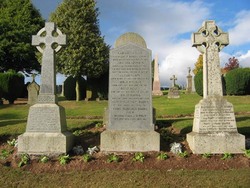 The Final Footprint – Barrie is interred in the Barrie and Ogilivie family plot in Kirriemuir Cemetery. The family plot is marked by three large upright markers. A bronze Peter Pan statue was erected in Kensington Gardens, London. Barrie was portrayed in the semi-biographical film, Finding Neverland (2004), by Johnny Depp. The film was nominated for an Oscar, as was Depp, and also stars Kate Winslet and Hoffman. Neverland Valley Ranch was named by Michael Jackson after Barrie’s Neverland.
The Final Footprint – Barrie is interred in the Barrie and Ogilivie family plot in Kirriemuir Cemetery. The family plot is marked by three large upright markers. A bronze Peter Pan statue was erected in Kensington Gardens, London. Barrie was portrayed in the semi-biographical film, Finding Neverland (2004), by Johnny Depp. The film was nominated for an Oscar, as was Depp, and also stars Kate Winslet and Hoffman. Neverland Valley Ranch was named by Michael Jackson after Barrie’s Neverland.
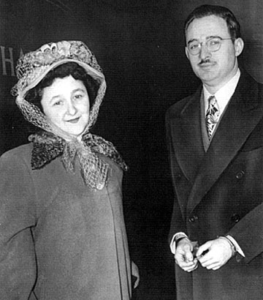 On this day in 1953 American citizens who were convicted of spying on behalf of the Soviet Union in 1951, Julius and Ethel Rosenberg were executed by the federal government of the United States in 1953 in the Sing Sing correctional facility in Ossining, New York, at the ages of 35 and 37. Julius Rosenberg was born on May 12, 1918, in Manhattan. Ethel Greenglass was born on September 25, 1915 in Manhattan. The couple were accused of providing top-secret information about radar, sonar, jet propulsion engines, and valuable nuclear weapon designs. At that time, the United States was the only country in the world with nuclear weapons.
On this day in 1953 American citizens who were convicted of spying on behalf of the Soviet Union in 1951, Julius and Ethel Rosenberg were executed by the federal government of the United States in 1953 in the Sing Sing correctional facility in Ossining, New York, at the ages of 35 and 37. Julius Rosenberg was born on May 12, 1918, in Manhattan. Ethel Greenglass was born on September 25, 1915 in Manhattan. The couple were accused of providing top-secret information about radar, sonar, jet propulsion engines, and valuable nuclear weapon designs. At that time, the United States was the only country in the world with nuclear weapons.
The Rosenbergs’ sons, Michael and Robert Meeropol and other defenders, maintained that Julius and Ethel were innocent of spying on their country and were victims of Cold War paranoia. After the fall of the Soviet Union, much information concerning them was declassified, including a trove of decoded Soviet cables, code-named VENONA, which detailed Julius’s role as a courier and recruiter for the Soviets and Ethel’s role as an accessory. In 2008 the National Archives of the United States published most of the grand jury testimony related to the prosecution of the Rosenbergs; it revealed that Ethel had not been directly involved in activities, though still acted as an accessory, and had full knowledge of Julius’s espionage activity and played the main role in the recruitment of her brother for atomic espionage.
Jean-Paul Sartre described the trial as
“a legal lynching which smears with blood a whole nation. By killing the Rosenbergs, you have quite simply tried to halt the progress of science by human sacrifice. Magic, witch-hunts, autos-da-fé, sacrifices – we are here getting to the point: your country is sick with fear … you are afraid of the shadow of your own bomb.”
Others, including Jean Cocteau, Albert Einstein, Nelson Algren, Bertolt Brecht, Dashiell Hammett, Frida Kahlo, and Diego Rivera, protested the position of the American government in what the French termed the US Dreyfus affair. Einstein pleaded with President Truman to pardon the Rosenbergs. In May 1951, Pablo Picasso wrote for the communist French newspaper L’Humanité, “The hours count. The minutes count. Do not let this crime against humanity take place.” The all-black labor union International Longshoremen’s Association Local 968 stopped working for a day in protest. Cinema artists such as Fritz Lang registered their protest. Pope Pius XII appealed to President Dwight D. Eisenhower to spare the couple, but Eisenhower refused on February 11, 1953.
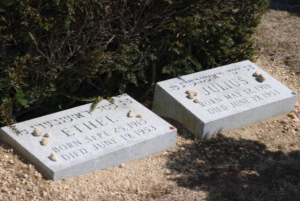 The Final Footprint
The Final Footprint
The funeral services were held in Brooklyn on June 21. Ethel and Julius Rosenberg were buried at Wellwood Cemetery, a Jewish cemetery in Pinelawn, New York. The Times reported that 500 people attended, while some 10,000 stood outside:
The bodies had been brought from Sing Sing prison by the national “Rosenberg committee” which undertook the funeral arrangements, and an all-night vigil was held in one of the largest mortuary chapels in Brooklyn. Many hundreds of people filed past the biers. Most of them clearly regarded the Rosenbergs as martyred heroes and more than 500 mourners attended to-day’s services, while a crowd estimated at 10,000 stood outside in burning heat. Mr. Bloch [their counsel], who delivered one of the main orations, bitterly exclaimed that America was “living under the heel of a military dictator garbed in civilian attire”: the Rosenbergs were “Sweet. Tender. And Intelligent” and the course they took was one of “courage and heroism.”
- The E. L. Doctorow novel The Book of Daniel (1971) is based on the Rosenberg case as seen through the eyes of a (fictionalized) son. Doctorow wrote the screenplay of the Sidney Lumet film Daniel, starring Timothy Hutton.
- The main character in Sylvia Plath’s novel The Bell Jar is morbidly interested in the Rosenbergs’ case. The novel begins with the sentence, “It was a queer, sultry summer, the summer they electrocuted the Rosenbergs, and I didn’t know what I was doing in New York.”
- Images of the Rosenbergs are engraved on a memorial in Havana, Cuba. The accompanying caption says they were murdered.
- The song “Julius and Ethel” by Bob Dylan is based on the Rosenberg case.
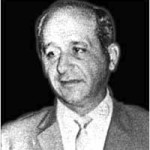 On this day in 1975, Sicilian American mobster and boss of the Chicago Outfit from 1957–1966, “Momo”, “Mooney”, “Sam the Cigar”, “Sammy”, Sam Giancana died from multiple gunshot wounds in his home in Oak Park, Illinois at the age of 67. Giancana was killed shortly before he was scheduled to appear before a U. S. Senate committee investigating supposed CIA and Cosa Nostra collusion in plots to assassinate President John F. Kennedy. Born Salvatore Giangana to Sicilian immigrants in Little Italy, Chicago.
On this day in 1975, Sicilian American mobster and boss of the Chicago Outfit from 1957–1966, “Momo”, “Mooney”, “Sam the Cigar”, “Sammy”, Sam Giancana died from multiple gunshot wounds in his home in Oak Park, Illinois at the age of 67. Giancana was killed shortly before he was scheduled to appear before a U. S. Senate committee investigating supposed CIA and Cosa Nostra collusion in plots to assassinate President John F. Kennedy. Born Salvatore Giangana to Sicilian immigrants in Little Italy, Chicago.
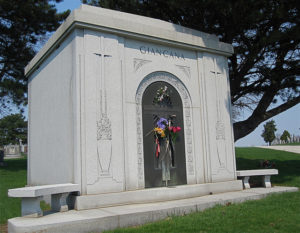 The Final Footprint – Giancana was entombed next to his wife Angelina in the Giancana family private mausoleum in Mount Carmel Cemetery in Hillside, Illinois.
The Final Footprint – Giancana was entombed next to his wife Angelina in the Giancana family private mausoleum in Mount Carmel Cemetery in Hillside, Illinois.
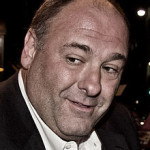 On this day in 2013, actor James Gandolfini died of an apparent heart attack in Rome at the age of 51. Born James Joseph Gandolfini, Jr. on 18 September 1961 in Westwood, New Jersey. Perhaps best known for his role in The Sopranos as Tony Soprano, a troubled crime boss struggling to balance his family life and career in the Mafia. Gandolfini garnered enormous praise for this role, winning both the Primetime Emmy Award for Outstanding Lead Actor in a Drama Series and Screen Actors Guild Award for Outstanding Performance by a Male Actor in a Drama Series three times.
On this day in 2013, actor James Gandolfini died of an apparent heart attack in Rome at the age of 51. Born James Joseph Gandolfini, Jr. on 18 September 1961 in Westwood, New Jersey. Perhaps best known for his role in The Sopranos as Tony Soprano, a troubled crime boss struggling to balance his family life and career in the Mafia. Gandolfini garnered enormous praise for this role, winning both the Primetime Emmy Award for Outstanding Lead Actor in a Drama Series and Screen Actors Guild Award for Outstanding Performance by a Male Actor in a Drama Series three times.
he Final Footprint – Gandolfini’s funeral service was held on 27 June 2013 at the Episcopal Cathedral of Saint John the Divine in Morningside Heights, New York City. He was cremated.
| Anton Yelchin | |
|---|---|
On this day in 2016 actor Anton Yelchin died at his home in Studio City, Los Angeles when his car accidentally pinned him against a fence, at the age of 27. Born Anton Viktorovich Yelchin on March 11, 1989 in Leningrad, now Saint Petersburg. Perhaps best known as Pavel Chekov in three Star Trek films: the first film, Star Trek (2009); the first sequel, Star Trek Into Darkness (2013); and the posthumously released Star Trek Beyond (2016). He was also known for his work in independent cinema.
Born to a Russian Jewish family, Yelchin relocated to the United States, where he began performing in the late 1990s, appearing in several television and film roles. His role for Steven Spielberg’s miniseries Taken was significant in furthering his career. He starred in multiple television series, including Huff and the posthumously released Trollhunters.
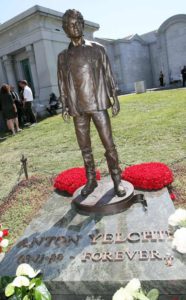 The Final Footprint
The Final Footprint
He was featured in the “In Memoriam” section during the 89th Academy Awards.
In October 2017, a bronze statue of Yelchin was erected at his grave in the Hollywood Forever Cemetery. Celebrities present at the unveiling ceremony included Jennifer Lawrence, Zoe Saldana, Simon Pegg, J. J. Abrams, Emile Hirsch, Demi Moore, Jon Voight, Drake Doremus and Jeremy Saulnier. Saldana spoke at the ceremony, paying tribute to Yelchin: “It is a bittersweet moment, because we’re here for Anton, and he’s not here with us. But, it alleviates my heart knowing that we’ll keep him alive. We’re going to keep remembering him in the hopes that by practicing all the things he believed in and remembering all the love that he gave us, and all the joy he gave us, we’re able to just keep him here with us.”
Other notable Final Footprints at Hollywood Forever include; Mel Blanc (yes, his epitaph is “That’s All Folks!”), Chris Cornell, Cecil B. DeMille, Victor Fleming, Judy Garland, Joan Hackett, John Huston, Jayne Mansfield’s cenotaph, Hattie McDaniel‘s cenotaph, Tyrone Power, Nelson Riddle, Mickey Rooney, Bugsy Siegel, Carl “Alfalfa” Switzer, Rudolph Valentino, Fay Wray, and Anton Yelchin.
Have you planned yours yet?
Follow TFF on twitter @RIPTFF

